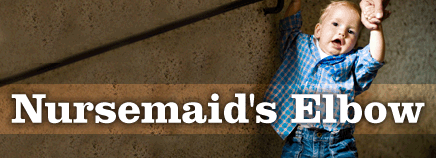
About Nursemaid’s Elbow
Toddlers and preschoolers are at risk for a common elbow injury called nursemaid’s elbow. This happens when a ligament slips out of place and gets caught between two bones of the elbow joint.
Sometimes it gets unstuck by itself. In most cases, a health care professional gets the ligament back in place by doing a quick, gentle move of the arm.
A child with nursemaid’s elbow has some arm pain when the injury happens, but it doesn’t cause long-term damage.
Causes
Nursemaid’s elbow (also called pulled elbow) usually happens in kids 1 to 4 years old. Their ligaments (the elastic-like bands that hold bones together) are a bit loose. So it can be easy for a ligament in the elbow to slip into the joint and get stuck.
Nursemaid’s elbow can happen with just a small amount of force. For example:
- Pulling a child up by the hands can put stress on the elbows. Never pick up a toddler or infant by the hands or wrists, but lift under the armpits.
- Swinging a toddler by holding the hands or wrists can put stress on the elbow joint and should be avoided.
- Jerking an arm when pulling a toddler along or quickly grabbing his or her hand can make the ligament slip. Always be gentle when taking a child by the hand.
- Breaking a fall by reaching an arm out for protection can overextend the elbow, causing the ligament to slip.
- Rolling over in an awkward way in a crib, bed, or on the floor can cause nursemaid’s elbow in infants and very young children.
As kids get older, the ligaments tighten. Most won’t get nursemaid’s elbow after they turn 5 years old, though it can happen up to age 6 or 7.
Signs and Symptoms
A child with nursemaid’s elbow will not want to use the injured arm because moving it is painful. He or she will keep the arm in a straight position or with a slight bend in the elbow. The injury won’t be obvious because nursemaid’s elbow doesn’t cause deformity or swelling.
An arm or elbow injury that causes severe pain might be a sign of an elbow fracture (broken bone) or a bad bruise. It can be hard for a parent to tell whether an injury is nursemaid’s elbow or a fracture, so it’s important to call your doctor if your child has injured an elbow.
Treatment
At a doctor’s office or an emergency room, a health care professional will examine the child’s arm and ask questions about how the injury happened. Usually, no special tests are needed to diagnose nursemaid’s elbow. X-rays are done only if a fracture is suspected.
If there’s no swelling or signs of another injury, the doctor will do a gentle maneuver called a reduction. This procedure takes only a few seconds. The child will sit on a parent’s lap while the doctor gently takes the arm from a straight position and bends it upwards or straightens the arm while turning the palm to the floor.
Kids might have a brief moment of pain during the reduction, but quickly feel much better. Most have full use of the arm within 5 to 10 minutes. Some cases may require more than one reduction to successfully fix the injury.
Occasionally, a child may not want to use the arm after a reduction, fearing it will be painful. If there is some discomfort, the doctor may put the arm in a sling and say it’s OK to give acetaminophen or ibuprofen for pain relief. In some cases, the doctor may place a splint (a partial cast) to protect the arm until a specialist can check it after a few days of rest.
Prevention
It’s important to know that kids who get nursemaid’s elbow might get it again. So be mindful of the risks and don’t pull, tug, or swing your child by the arms or hands, and be sure to tell all caregivers to do the same.
Still, some kids are just more prone to getting nursemaid’s elbow than others and might get it again even when parents try hard to prevent it.

